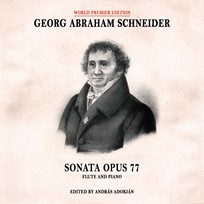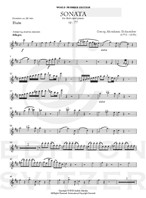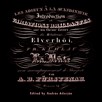
Sonata Opus 77
Composer: Georg Abraham Schneider
Instrument: Flute and Piano
Level: Intermediate
Published: 2012
Price: €28.00
Item details
-
Description +
-
Edited by András Adorján
Duration: 22 min.
Georg Abraham Schneider (1770-1839), a contemporary of Beethoven, had an important role in the musical scene of the early 19th century Berlin. His large, and hitherto unpublished, four-movement Sonata for „Pianoforte and Flute“ in D-major, opus 77, which was composed around 1810 presents a welcome addition to the classic / early romantic flute repertoire. Incidentally it is also a rare example of the appearance of the piano in this composer’s musical oeuvre; being an instrument which he otherwise preferred to neglect.
-
-
Instrumentation +
-
Flute and Piano
-
-
About the composer +
-
George Abraham Schneider (b. Darmstadt, April 19, 1770; d. Berlin, January 19, 1839) was a German horn virtuoso, oboist, conductor, and composer. After becoming proficient on the horn, he studied theory with J. G. Portmann. He had a rare knowledge of musical instruments and learned to play both winds and strings. In addition to playing horn in the court orchestras of Darmstadt, Schwerin, Rheinsberg, and Berlin, he also played the oboe in a Hessian regiment.
In ca. 1813 he became theatrical conductor at Reval. He moved to Berlin in 1816, and in 1820 was engaged as Kapellmeister of the court opera and director of military bands. A prolific composer, he wrote numerous works for winds in addition to his operas, masses, and symphonies. He states in his own catalog of works that he composed 46 quartets for the bassoon. Eighteen quartets for bassoon and strings are located in the Deutsche Staatsbibliotek, Berlin, manuscript no. G. A. Schneider: 72 M. These quartets are divided into three sets, each containing six works. The present Quartet No. 1 in F Major is the first work in what is presumably the third set.
-




